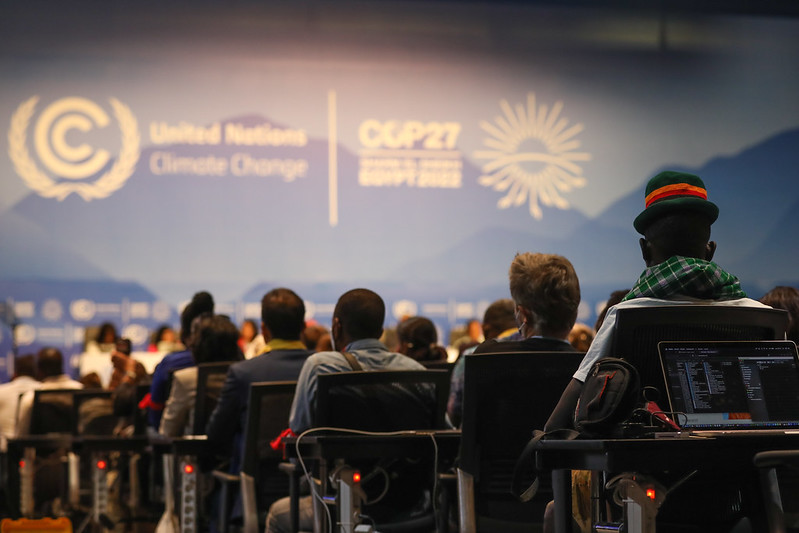Not all COPs are made equally. After 2021’s COP26 in Glasgow – successfully hyped up by the Boris Johnson-led UK as a showcase of ‘Global Britain’s’ diplomatic mettle – COP27 in in Egypt was perhaps always fated to be a less significant one.
Weak organisational and diplomatic capacity in the authoritarian state made underwhelming outcomes even more likely. Nevertheless, not every COP is supposed to deliver ground-breaking announcements and to expect so is not doing the COP and UNFCCC process any favours.
COP21 in Paris delivered the Paris Agreement, a momentous watershed in global governance that bound nearly 200 countries to a binding, bottom-up process whereby ambition levels are ratcheted in five-year cycles as Parties pledge more domestic climate action.
The Glasgow COP focused political attention on near-term emissions reduction efforts – especially by richer countries – while also successfully concluding technical negotiations to operationalise the Paris Agreement. The COPs in between were by no means a failure but rather laid the groundwork for these larger political deals.
Not a bad COP, not necessarily a good one either…
COP27 led to one major breakthrough amidst a slew of deferrals and tortured compromise texts on mitigation: for the first time, an agreement on loss and damage compensation was found. Loss and damage represent one of the most fundamental fault lines between the developing and developed countries.
Having contributed negligible amounts to the problem (CO2 concentrations in the atmosphere) while facing some of the greatest climate impacts, developing countries baulk at the prospect of having to foot the bill for the damages of climate change themselves. Richer countries meanwhile fear the long-term liability that comes with agreeing to loss and damage compensation.
The agreement on loss and damage is not at all concrete yet. It is unclear how much finance will be made available, who will cough up the money, who will be eligible to receive funds or what the wider institutional arrangements will be. Nevertheless, this first official inclusion will mean that future COPs will return to flesh this out, even if outcomes depend on future diplomacy.
The best way to limit loss and damage financing would be to limit the amount of loss and damage in the first place. Here, the COP was seen as disappointing as there was no strengthening of the language on the ‘phasedown’ of coal, or fossil fuels more generally, while it actually took effort to maintain language on the 1.5C target. Looking at the design of the Paris Agreement, the moment when countries should really put-up increased commitments is during the ‘global stocktake’, the first one which finishes in 2023, followed by a new five-year cycle up to 2028.
Beyond the headline decisions, as with every COP, distinguishing between the political, the legal and the technical is useful when assessing outcomes.
Look to individual countries…
Politically, this COP was billed as the ‘implementation COP’. Implementation in ‘COP-speak’ rather means what the rest of the world refers to as ‘climate policy’, in particular mitigation efforts, i.e. emissions reductions.
Crucially, the UNFCCC has no formal competence in compelling countries to implement certain climate policies. Nor does the Paris Agreement ask this – it only binds them to a process. But by dubbing it the ‘implementation COP’, countries were spurred on to announce actual policies and strategies to deliver emissions reductions… or at least to showcase them.
Hence, the US could extol the virtues of its Inflation Reduction Act, a massive federal industrial policy package purported to be climate policy while masquerading as fiscal policy. South Africa – one of the most coal-dependent countries in the world – announced a USD 84 billion transition plan to renewables. The return of Lula in Brazil meanwhile came with a pledge to reverse the Amazon’s intensifying deforestation.
The EU has long been well equipped with its Green Deal, although it was challenged to explain the ramifications of the REPowerEU interventions – induced by the ongoing energy crisis – and the rebound in coal use (spoiler: the EU ETS caps emissions, namely emissions permits demanded by coal-burning utilities, are no longer available to other industries).
Nevertheless, the EU was able to present a higher emissions reduction target for 2030 of 57 %. The two-point increase was in fact the result of the agreement on the LULUCF Regulation, which should lead to a larger EU land carbon sink. This shows the dominance of domestic policies in truly delivering emissions reductions.
Just as in the EU, it takes a while before a technical rulebook is truly complete (if that ever happens at all). Here, the Sharm El Sheikh COP can be seen as underwhelming as well. Article 6 still cannot be fully operationalised, although the inter-country trading of Art 6.2 is getting there. For the projects-based Art 6.4, some very fundamental choices ostensibly remain open, including potential interactions between ‘compliance’ trading and voluntary carbon markets, or the transparency of projects, crucial for the credibility of any ‘credits’ created.
… and to global GHG emissions
COPs can (and ideally should) spur domestic climate action, but equally, COPs can simply reflect what is going on in countries and the wider world. The world of 2022 is marked by war, geopolitical turmoil, and energy and food crises.
Instigators of these developments also participate in the COP, including Russia. It stretches the limits of credulity that a country such as current-day Russia – but also some other authoritarian states – will ever contribute remotely constructively to global climate action. Effective climate action will always be made at lower levels than the UN. The real metric to keep an eye on is global GHG emissions.
In the aftermath of Paris, global emissions for a long time seemed to be peaking. In recent years, they are, however, hitting new heights. If during this decade global emissions do not start a steep downward trajectory, critics of the current UNFCCC and COP approaches will feel themselves vindicated.
Next year’s COP in Dubai, when the first global stocktake finishes, will be a good marker – even if global climate ambitions will most likely remain driven by the sum of collective domestic actions, not international summitry.
About the author:


